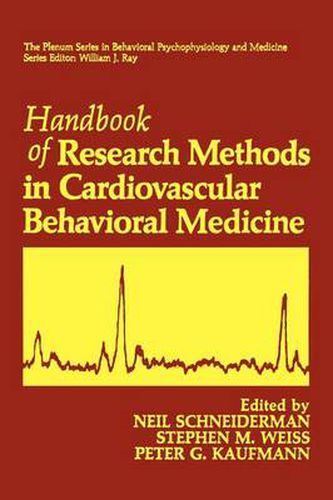Readings Newsletter
Become a Readings Member to make your shopping experience even easier.
Sign in or sign up for free!
You’re not far away from qualifying for FREE standard shipping within Australia
You’ve qualified for FREE standard shipping within Australia
The cart is loading…






This title is printed to order. This book may have been self-published. If so, we cannot guarantee the quality of the content. In the main most books will have gone through the editing process however some may not. We therefore suggest that you be aware of this before ordering this book. If in doubt check either the author or publisher’s details as we are unable to accept any returns unless they are faulty. Please contact us if you have any questions.
Cardiovascular disease continues to be the number ioral medicine was developed and shaped into the one source of morbidity and mortality in our coun- following definition: try. Despite a 35% reduction since 1964, these Behavioral medicine is the interdisciplinary field con- diseases, particularly coronary heart disease cerned with the development and integration of behav- (CHD), claim nearly 1,000,000 lives each year in ioral and biomedical science knowledge and techniques the United States (Havlik & Feinleib, 1979). relevant to the understanding of health and illness and The Framingham study, among others, has iden- the application of this knowledge and these techniques to prevention, diagnosis, treatment and rehabilitation. tified three major risk factors implicated in the de- (Schwartz & Weiss, 1978) velopment of CHD: smoking, elevated serum cho- lesterol, and high blood pressure (Castelli et at., This concept of biobehavioral collaboration 1986). Given that these factors account for less challenged scientists and clinicians of many disci- than 50% of the variance associated with CHD plines to consider how they might more effectively (Jenkins, 1976), it has become obvious that addi- develop diagnostic, treatment, and prevention tional risk factors must be identified if further pro- strategies by merging their perspectives to address gress is to be made in disease prevention and simultaneously, among others, behavioral, psy- control.
$9.00 standard shipping within Australia
FREE standard shipping within Australia for orders over $100.00
Express & International shipping calculated at checkout
This title is printed to order. This book may have been self-published. If so, we cannot guarantee the quality of the content. In the main most books will have gone through the editing process however some may not. We therefore suggest that you be aware of this before ordering this book. If in doubt check either the author or publisher’s details as we are unable to accept any returns unless they are faulty. Please contact us if you have any questions.
Cardiovascular disease continues to be the number ioral medicine was developed and shaped into the one source of morbidity and mortality in our coun- following definition: try. Despite a 35% reduction since 1964, these Behavioral medicine is the interdisciplinary field con- diseases, particularly coronary heart disease cerned with the development and integration of behav- (CHD), claim nearly 1,000,000 lives each year in ioral and biomedical science knowledge and techniques the United States (Havlik & Feinleib, 1979). relevant to the understanding of health and illness and The Framingham study, among others, has iden- the application of this knowledge and these techniques to prevention, diagnosis, treatment and rehabilitation. tified three major risk factors implicated in the de- (Schwartz & Weiss, 1978) velopment of CHD: smoking, elevated serum cho- lesterol, and high blood pressure (Castelli et at., This concept of biobehavioral collaboration 1986). Given that these factors account for less challenged scientists and clinicians of many disci- than 50% of the variance associated with CHD plines to consider how they might more effectively (Jenkins, 1976), it has become obvious that addi- develop diagnostic, treatment, and prevention tional risk factors must be identified if further pro- strategies by merging their perspectives to address gress is to be made in disease prevention and simultaneously, among others, behavioral, psy- control.